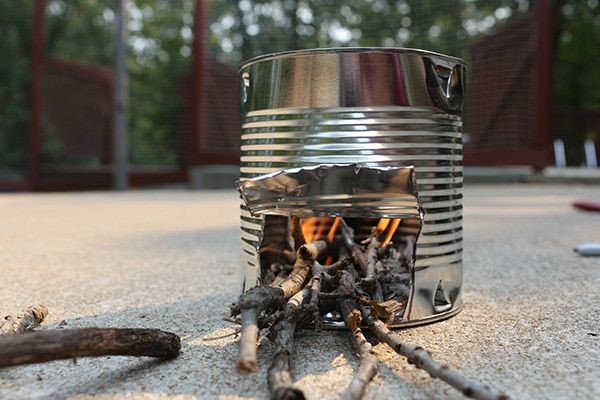Klondike Hobo Stove

Take a coffee can (exact size not important — experiment).
Cut holes in the sides of the can as below: Substitute 3# coffee can for paint can.
(if it is a paint can, it must be a new clean paint can)

Put anything combustible in and light it up.
The air flows in the bottom hole, and the aerodynamics of the can suck the exhaust out of the top holes. This forms a vicious through draught, and the fire burns almost white hot in a strong wind! It also uses very little fuel. Fire temperature can be controlled by turning the can away from the wind a bit, or by obstructing the inlet hole.
Put a pan directly on the top of the can without the can lid (unless you are very fussy
about carbon deposits on your pan) for maximum heat transfer. Or to bake, put the lid on the can, and the baking receptacle on the lid. Alternatively use a large lidded tin, like a biscuit tin, directly on the can, supporting the item to be baked above the bottom of the tin, so it bakes in the distributed temperature of the tin rather than the direct heat on the base.
These things are unbelievably effective, dirt-cheap, and fun to make. You can easily make one on the fly with a Swiss Army knife and a tin you pick up. You will probably find yourself making lots of different designs just for the hell of it!! They are also useful in that you can burn up your camp rubbish to cook your next meal!
Alternative option
Tin Can Stove
You can build your own camp cooking system for next to nothing. Start with a coffee can. Cut out the top, dump the coffee and let the lid fall to the bottom of the can. Now, turn the can over and hold the free lid tight against the bottom inside of the can.
1. Use a church key can opener to punch 10 or 12 vent holes around the outside of the can near the bottom. The metal that the opener pokes into the can will hold the free lid in place. This will be a double top that will serve as your cooking surface. The two layers of metal will help distribute the heat more evenly and slowly.
2. At the open end of the can, cut two 3-inch-long slits up the side about 4 inches apart. You can bend this “door” up to fuel the stove.
3. Fuel the stove with a homemade “buddy burner.” Start with an empty tuna can. Cut strips of corrugated cardboard that measure about an inch in width. Coil the cardboard inside the can so that it is completely filled, but not crammed. Melt paraffin wax into the can until it is full. A wick is useful, and can be made from an inch of wax-soaked string. It will burn for about two hours. Replenish the fuel by simply melting more wax into the cardboard coil.